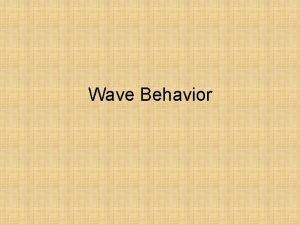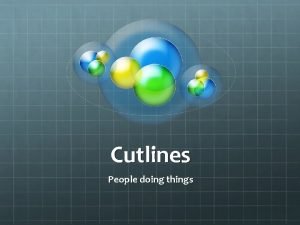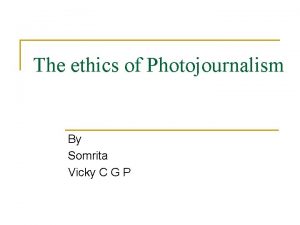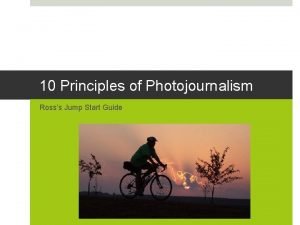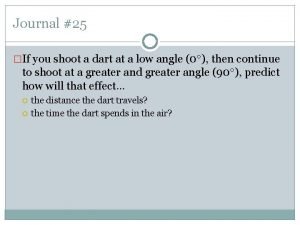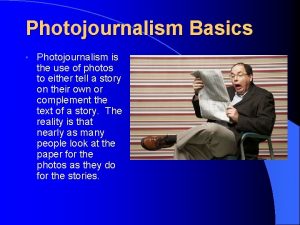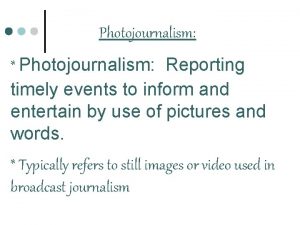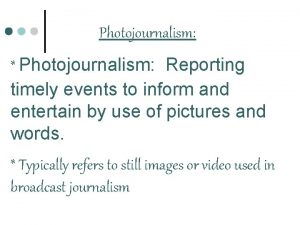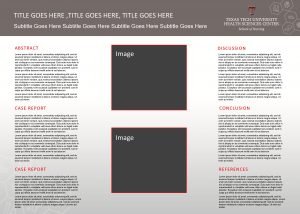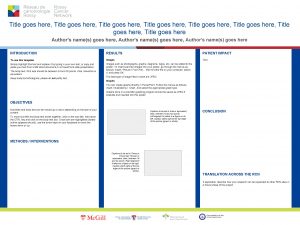Photojournalism Composition This is what goes into a















- Slides: 15

Photojournalism

Composition �This is what goes into a picture. You need to ask yourself questions before you raise the camera to your eye. �What’s in the picture? Who’s in the picture? Why are you taking this picture? Who is the audience? Does it go with a story? Is it a stand alone pic?

Elements of Composition �Drama. The picture that says to the view, “Something is going on here, ” is likely to hold the viewer’s interest. A single picture rarely tells a complete story, but it can suggest something to the viewer that will hold the viewer’s attention. Choose something that will get their attention.

Element �Action. Movement is a great interest-generating element. Viewers understand that in pictures with movement, something happened before and after the picture was taken.

Elements �Unusualness. Photographs like to show what people do not normally see. They like to capture the unique or bizarre moments of people’s lives. To find these things, they have to look where other people are not looking and be where most other people are not normally found.

Lighting � A good portion of a good pic is all about lighting. This will change and effect the viewer’s perspective. � Natural light is always best. � Never shoot into the sun – unless doing so for effect. Try to keep the light source projected onto the subject. � Never shoot towards a reflective surface with a flash. � Gym lighting will ALWAYS be dark. � Florescent lighting gives people a sickly pall. Try to move them outside when possible for headshots or simple pics. � For BWHS purposes: NEVER use a flash at a sporting event. � For BWHS purposes: NEVER show a student athlete their pic until AFTER their competition is finished (this is illegal and could get them in trouble)

Types of shots �Long range: how far away are you? How much do you want to show the reader? Long range shots show the reader more of what’s happening, but they are NOT close ups. �Example: stand shots at football games. We want a long range view to show the people are reacting.

Mid-Range �Shows reader some facial expressions, but also shows a great deal of action. �Best for general sports shots. �Must watch for cut off limbs, faces, etc with midrange pics.

Close Ups �Used to show facial expressions; feelings. �Used to show individual athletes excelling or messing up. �Cut out all the random extra sights surrounding the subject.

General �Take numerous shots of whatever event you are covering. �You never know what you might pick up in a shot. �Be aware of the background of a picture. �Are people in the stands flipping off the ref? Is someone wearing something inappropriate? Etc. You might have the most amazing pic – but the background might jeopardize that pic ever seeing the light of day.

Perspective �Adhere to the compass when taking pics. Take shots from the north, south, east, and west

Perspective �Change your height. Stand on something to get a higher view. Hold the camera above your head and point it in the direction of the shot. Climb the bleachers and get a higher angle. Kneel down. Lay on the ground. Unusualness. Photographs like to show what people do not normally see. They like to capture the unique or bizarre moments of people’s lives. To find these things, they have to look where other people are not looking and be where most other people are not normally found. And they have to have their camera’s up and ready to shoot. Shoot up towards the subject.

Perspective �Centering: Not everything needs to be centered. Sometimes an interesting pic isn’t centered in the middle of the action. Leave some space for viewers’ eyes to be drawn to the action.

BWHS Specific �Online: We can’t put pictures that identify students in the paper. But we can put pics with faces distorted online. Wide shots and long range shots work best for online

BWHS Specific �Boards: This is were we can showcase what the staff can do. Close ups are encouraged. Take some risks with your pics. We have two boards – the athletic board and the one outside Room 400. I would love to change these boards as often as possible – like a real newspaper; when news happens we’re on top of it. We are known for YOUR pics. I get asked by teachers to use YOUR pics for various things all the time. Take pride in that.
 Composition techniques in photojournalism
Composition techniques in photojournalism What happens when a wave strikes an object and bounces off
What happens when a wave strikes an object and bounces off Photojournalism rules
Photojournalism rules Father of photojournalism
Father of photojournalism History of photojournalism timeline
History of photojournalism timeline Photojournalism job
Photojournalism job What is photojournalism
What is photojournalism Example of cutline
Example of cutline Modern photojournalism
Modern photojournalism Eddie adams
Eddie adams Basic principles of photojournalism
Basic principles of photojournalism Photojournalism jobs
Photojournalism jobs Laws and ethics of photojournalism
Laws and ethics of photojournalism Refers to the path the projectiles make
Refers to the path the projectiles make Title text goes here
Title text goes here Nonconformity that goes undetected by those in authority.
Nonconformity that goes undetected by those in authority.

